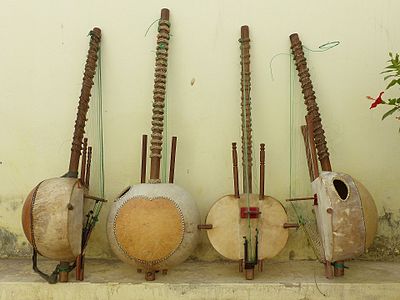
The kora is a unique and fascinating musical instrument that is native to West Africa. It is a stringed instrument that is often referred to as a harp-lute due to its combination of a large harp-like body and a long lute-like neck. The kora has become synonymous with the music of West Africa, and its history and cultural significance are as rich and diverse as the music that it produces.

Kora Origins and History
The kora is believed to have originated in the Mande region of West Africa, which includes modern-day countries such as Mali, Guinea, and Senegal. It has a long history that dates back to at least the 13th century, and it was initially played by the griots, who were West African storytellers and musicians. Griots were highly respected members of society, and their music was used to celebrate important events such as weddings, births, and funerals.
The kora was initially a simple instrument that was made from gourds and animal skins. Over time, it evolved into a more complex instrument with a wooden frame and a larger number of strings. Today, the kora typically has 21 strings, although there are variations that can have up to 26 strings.
What family of instrument does the kora belong to? The kora belongs to the family of stringed instruments. More specifically, it is a type of bridge-harp lute, which means it has a large harp-like body with a long neck that has a fretboard and tuning pegs. The strings are attached to the body of the instrument and run up the neck where they are attached to the tuning pegs. The musician plucks the strings with their fingers to create sound. The kora is unique among stringed instruments due to its large size and number of strings, which makes it a highly distinctive and recognizable instrument.
Playing the Kora
Playing the kora requires a unique and complex technique. The musician plucks the strings with both hands, using the thumbs and forefingers to create intricate melodies and rhythms. The left hand is used to play the lower strings, while the right hand plays the higher strings. The musician can also use the left hand to mute or dampen the strings, creating a percussive effect that adds to the complexity of the music.
The kora is often played solo, although it is also used in ensembles with other traditional West African instruments such as the balafon and djembe. The music that is created with the kora is intricate and complex, with the musician weaving together multiple melodies and rhythms to create a unique sound.
Is the kora difficult to play? Yes, the kora is generally considered a difficult instrument to play due to its unique design and playing technique. The kora has 21 strings, which can be challenging to master, and the musician must use both hands to pluck the strings and create melodies and rhythms. Additionally, the musician must learn to mute or dampen the strings with their left hand to create percussive effects.
Kora Cultural Significance
The kora has significant cultural and spiritual importance in West African society. It is closely associated with the griots, who are the keepers of West African history and tradition. Griots use the kora to tell stories and to convey important cultural and historical information.
The kora is also associated with the jali, who are a caste of musicians and storytellers. The jali were traditionally responsible for entertaining royalty and other members of high society, and their music was an important part of West African court life.
Today, the kora is a symbol of West African culture and is often used in festivals and other cultural events. It is also an important instrument in the global music scene, with musicians from around the world incorporating the kora into their music.
Famous Kora Players
There have been many famous kora players throughout history, each of whom has contributed to the evolution of the instrument and the music that it produces. Some of the most famous kora players include:
Toumani Diabaté: Toumani Diabaté is one of the most famous kora players in the world. He comes from a family of griots, and he has been playing the kora since he was a child. Toumani has released numerous albums and has collaborated with musicians from around the world.
Mamadou Diabaté: Mamadou Diabaté is another famous kora player who comes from a family of griots. He has been playing the kora since he was a child, and he has released several albums.
Ballaké Sissoko: Ballaké Sissoko is a Malian kora player who has collaborated with musicians from around the world. He has released several albums, including the critically acclaimed “Chamber Music.”
In conclusion, the kora is a unique and beautiful musical instrument with a rich cultural and historical significance. It is an important part of West African music and is becoming increasingly popular around the world. The intricate melodies and rhythms that are created with the kora are a testament to the skill and talent of the musicians who play it.
What is a Cimbalom?
What is a Stylophone?
What is an Otomatone?
What is a Cuica?
What is a Tam-Tam?
What is a Güiro?
